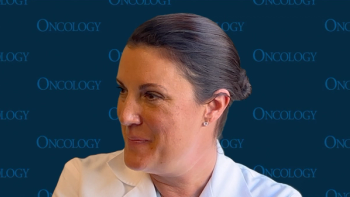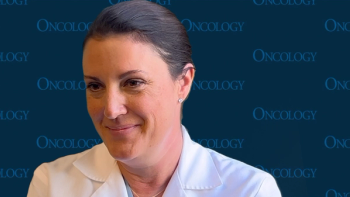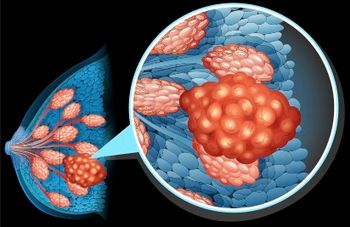
- ONCOLOGY Vol 11 No 6
- Volume 11
- Issue 6
Docetaxel in Combined Modality Therapy for Breast Cancer
Since the emergence of paclitaxel (Taxol) in 1983, clinical developmentof the taxoids has progressed at a rapid pace, with the introduction ofdocetaxel (Taxotere) into clinical trials in 1990, and international phaseII studies in 1992. Although these two taxoids are related, increasingclinical experience indicates that paclitaxel and docetaxel should notbe considered interchangeable.
Since the emergence of paclitaxel (Taxol) in 1983, clinical developmentof the taxoids has progressed at a rapid pace, with the introduction ofdocetaxel (Taxotere) into clinical trials in 1990, and international phaseII studies in 1992. Although these two taxoids are related, increasingclinical experience indicates that paclitaxel and docetaxel should notbe considered interchangeable.
In "Docetaxel in Breast Cancer and a Rationale for CombinationTherapy," I discuss some of the combination chemotherapy studies thathave been conducted or are ongoing. The challenge is not only to find effectivecombinations, strategies, and regimens, but also to determine the optimalrole for docetaxel in relation to many other active agents currently indevelopment.
Doxorubicin has long been recognized as one of the most effective singleagents used in the treatment of metastatic breast cancer, and doxorubicincombinations are among the most active in advanced or metastatic disease.These observations were included in the rationale for a feasibility studyusing doxorubicin and docetaxel in combination. In "Docetaxel in CombinationWith Doxorubicin: A Phase I Dose-Finding Study," Dr. VéroniqueDiéras reports on a phase I clinical trial using docetaxel in combinationwith doxorubicin for the treatment of metastatic or advanced disease.
In "Docetaxel and Cyclophosphamide in Patients With Advanced SolidTumors," Dr. Vicente Valero reports on the design and initial resultsof a phase I study to evaluate efficacy and safety of docetaxel/cyclophosphamidecombination therapy for metastatic breast cancer.
Also reported are two trials of docetaxel used in combination with doxorubicinand cyclophosphamide (Cytoxan, Neosar). A feasibility study was performedfor the docetaxel arm of a larger phase III trial, in which docetaxel combinedwith doxorubicin and cyclophosphamide is used alone or as induction beforehigh-dose chemotherapy, supplemented by autologous peripheral blood stem-celltransplantation. Preliminary results of this study are reportedby Dr. Nabholtzand colleagues in "Docetaxel/Doxorubicin/Cyclophosphamide in the Treatmentof Metastatic Breast Cancer."
In "Docetaxel Combined With Vinorelbine: Phase I Results and NewStudy Designs," Dr. Pierre Fumoleau and colleagues report on a phaseI dose-findingand pharmacokinetic study of vinorelbine (Navelbine) anddocetaxel as first-line chemotherapy for metastatic breast cancer.
Dr. Rowinsky and colleagues present preliminary results of a phase Iclinical trial testing the feasibility of docetaxel in combination withfluorouracil (5-FU) in their report "Docetaxel in Combination WithFluorouracil: Study Design and Preliminary Results."
In the final report in this supplement, "Preoperative DoxorubicinPlus Cyclophosphamide Followed by Preoperative or Postoperative Docetaxel,"Dr. Eleftherios Mamounas discusses a National Surgical Adjuvant Breastand Bowel Program protocol involving the use of docetaxel as adjuvant therapyfor early breast cancer.
Current or future clinical trials will evaluate docetaxel/anthracyclinecombinations in first-line therapy. One study will investigate the effectsof scheduling, dosing interval, high-dose chemotherapy, and combinationtherapy with cyclophosphamide. Clinical trials of docetaxel combined withvinorelbine and 5-FU, with and without granulocyte-colony stimulating factor(G-CSF, filgrastim [Neupogen]), are also planned.
Articles in this issue
over 28 years ago
Use of Adjuvent Analgesics Profiled at Pain Conferenceover 28 years ago
Chromosomal Changes Linked to Family History of Lung Cancerover 28 years ago
Bacterial Infection in Patients With Cancer: Focus on Preventionover 28 years ago
Role of Diet in Cancer Hard to Study, Expert Saysover 28 years ago
Guidelines for the Early Referral of Patients to Cancer Specialistsover 28 years ago
New Drugs May Brighten Ovarian Cancer Pictureover 28 years ago
Researchers Hope Function of BRCA1 Gene Holds Key to New Treatmentsover 28 years ago
Research Points to Effectiveness of Brachytherapy in Early ProstateNewsletter
Stay up to date on recent advances in the multidisciplinary approach to cancer.


















































































